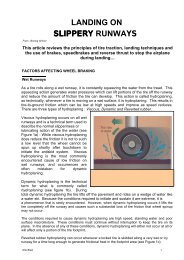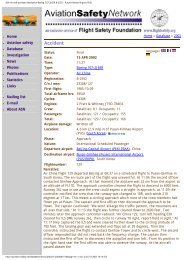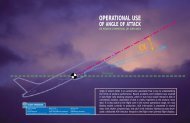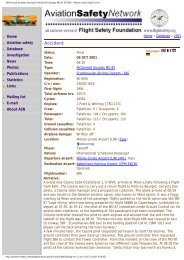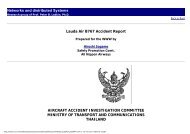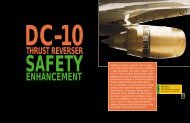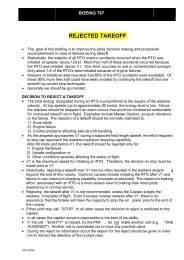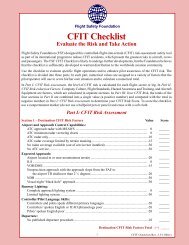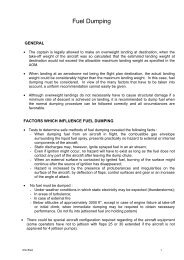Boeing 737-236 series 1, G-BGJL: Main document - Leonardo
Boeing 737-236 series 1, G-BGJL: Main document - Leonardo
Boeing 737-236 series 1, G-BGJL: Main document - Leonardo
You also want an ePaper? Increase the reach of your titles
YUMPU automatically turns print PDFs into web optimized ePapers that Google loves.
Many survivors from the front six rows of seats described a rollof thick black smoke clinging to the<br />
ceiling and moving rapidlyforwards along the cabin. On reaching the forward bulkheads itcurled<br />
down, began moving aft, lowering and filling the cabin.Some of these passengers became engulfed<br />
in the smoke despitetheir close proximity to the forward exits. All described a singlebreath as<br />
burning and painful, immediately causing choking. Someused clothing or hands over their mouths<br />
in an attempt to filterthe smoke; others attempted to hold their breath. They experienceddrowsiness<br />
and disorientation, and were forced to feel their wayalong the seat rows towards the exits, whilst<br />
being jostled andpushed. Many, even in the forward cabin, resorted to going overthe seat backs in<br />
order to avoid the congested aisle. This wasreported by passengers in seats 7A, 6B, 5D, 3E, 3Fand<br />
2F, in additionto statements from passengers who confirmed that they had goneforwards over the<br />
seats. Some stated that "the smoke generatedan immediate sense of panic".<br />
At the start of evacuation from the L1 door, the stewardess statedthat passengers seemed to be<br />
jammed in the cabin aisle and entranceto the galley (ie between the twin forward bulkheads). She<br />
clearedthe jam by pulling one young passenger forwards and the flow thenstarted. Later she saw a<br />
young girl lying on the floor of theforward aisle. She pushed another youth back, pulled the<br />
girlforward by her collar and pushed her down the slide. As the passengerscame forward through<br />
the bulkhead aperture so the smoke builtup in the forward galley area. She recalled feeling a body<br />
slumpagainst her legs, bent down and, due to improved visibility nearthe floor, saw that it was<br />
another girl passenger. Her face wasblack with soot, eyes fixed and dilated with no signs of<br />
breathing.The stewardess considered giving her the kiss of life when a firemandown below shouted<br />
for her to throw the girl down to him. Withgreat difficulty she lifted her by the waist and threw her<br />
ontothe chute. After being forced down by the smoke onto her handsand knees, the stewardess felt<br />
around for other passengers backas far as the galley cabin entrance. She was considering gettingher<br />
smokehood when a fireman shouted at her to jump, concernedthat she would perish if she delayed.<br />
Having been unable to locateany further passengers, she went down the slide.<br />
The Purser stated that, after getting the R1 door open at hissecond attempt and initiating evacuation<br />
from this exit, the smokebegan entering the galley area. He stood with his back to thegalley<br />
bulkhead with the door on his right, pushing passengerspast towards the chute. He stated that<br />
passengers were not carryingany "noticeable or unacceptable hand baggage". The densityof the<br />
smoke increased very rapidly, and became very acrid. Itbecame so bad that he could not see across<br />
the galley, and thencould not see his slide as the visibility went down to inches.Smoke was by this<br />
time pouring out of the door. He inhaled somesmoke and felt that if he inhaled any more, he would<br />
not survive.A number of people came out of the cabin and he followed themonto the slide.<br />
The aisle aperture between the twin forward bulkheads in thisconfiguration was 22¤ inches wide,<br />
effectively restrictingpassengers approaching along the aisle and over the seat backsto a single-line<br />
exit flow in spite of both forward doors beingopen from approximately 1 minute 10 seconds after<br />
the aircraftstopped. Many passengers, in addition to the two females assistedby the stewardess,<br />
collapsed in this area but survived. Unfortunatelyone of these passengers, (from seat 8B) who was<br />
found some 33minutes after the aircraft stopped, died some 6 days later dueto lung damage and<br />
associated pneumonia. Four bodies were eventuallyrecovered from the area of the forward aisle.<br />
The 18 passengers from the front 3 rows of seats appear to haveescaped from the forward exits<br />
before being affected by the smoke.In addition 3 passengers from row 13 and 2 passengers from<br />
row14 were also unaffected. Thus, of the 17 passengers who escapedfrom the L1 exit and 34<br />
passengers who escaped from the R1 exit,some 23 (45%) escaped before the thick smoke had<br />
reached them.



